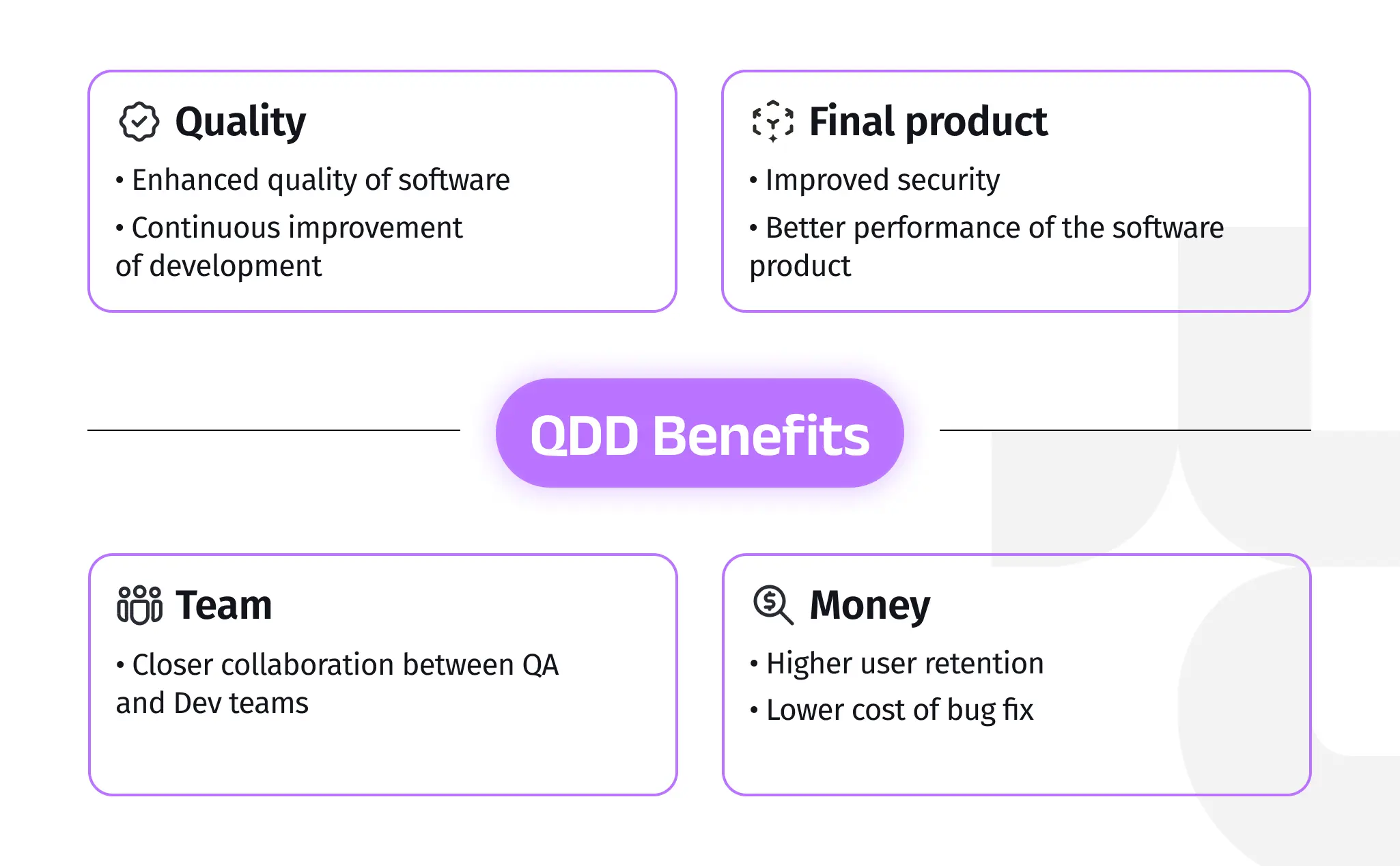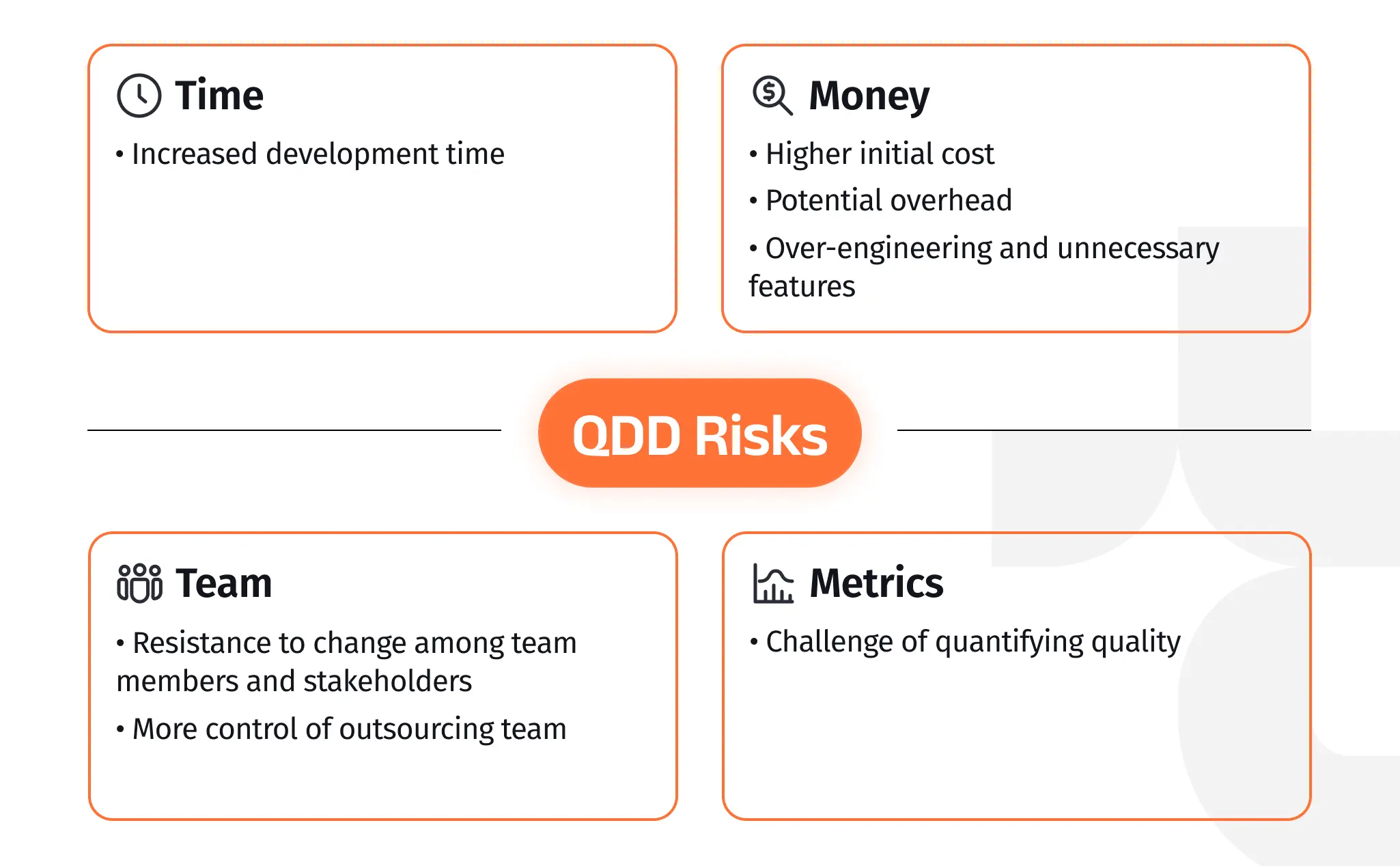Software Quality Assurance: The Backbone of Business Resilience
September 4, 2024
Software Quality Assurance establishes essential groundwork for creating top-tier software products and streamlined development processes. High-standard QA practices result in fewer bugs and better performance which leads to increased user satisfaction.
A 2022 CISQ report (the most recent available as of 2025) revealed staggering numbers: U.S. businesses lost $2.41 trillion to software defects and inefficiencies, with technical debt alone ballooning to $1.52 trillion.¹ More recent industry tracking shows the problem is only accelerating – Capgemini’s World Quality Report 2024 found that 68 % of firms are leaning on Gen-AI to rein in quality-related costs.²
Addressing this software technical debt requires the rapid implementation of comprehensive quality assurance measures. Effective quality control measures enable organizations to reduce substantial costs, underscoring the importance of prioritizing proper QA investments from the outset. Finding problems early saves money, but discovering bugs later leads to greater costs.
QA outsourcing services extend beyond basic software testing to cover multiple functions. The activities involved span multiple aspects, ensuring that software meets specific standards and requirements, which ultimately lead to top-quality products. Software quality assurance prevents defects through proactive methods, while testing reveals existing defects in the software.
Quality measures must be planned throughout development stages and controlled with assurance measures that facilitate continuous improvement.
Key principles of software testing and quality assurance
1. Quality begins with specification
Correct software development starts with accurate requirements documentation that remains both consistent and testable while fitting within specified budget and time constraints. The initial step lays the foundation for forthcoming quality control measures which prevents misunderstandings and errors while eliminating the necessity for rushed work or overtime.
2. Software quality control throughout the development lifecycle
To improve software quality, management organizations must implement practices beyond the scope of specification reviews. It includes key practices such as:
- Test-Driven Development (TDD) requires developers to write tests before writing code, which helps ensure software reliability and minimize errors.
- Behavior-Driven Development (BDD) builds upon Test-Driven Development (TDD) by utilizing natural language scenarios and examples, which enhance communication and understanding between technical developers and non-technical stakeholders.
- In code reviews, peers examine each other’s code to maintain quality standards while exchanging knowledge.
- Technical debt control involves regularly enhancing code to prevent potential future problems.
- Security testing aims to discover and eliminate vulnerabilities to protect against cyber threats.
- Performance testing encompasses both load testing, which monitors behavior under heavy traffic conditions, and stress testing, which establishes system limits and endurance levels.
- The usability testing process begins during the UI design stage and extends until user acceptance testing is completed.
- Production software requires ongoing availability checks with efficiency improvements made as needed.
- The business should analyze customer feedback to implement essential changes that will improve the overall user experience and satisfaction levels.
Quality Driven Development (QDD) requires a significant commitment to both implementing and maintaining continuous improvement through these practices. Integrating multiple AI assistants into processing workflows enables task automation while delivering insights and enhancing quality control measures.
3. CI/CD for software quality assurance
Through Continuous Integration and Continuous Delivery (CI/CD), software quality improves while Quality Assurance feedback is delivered in a timely manner. CI/CD systems facilitate automated integration and deployment processes, resulting in comprehensive testing and efficient updates.
Embedding testing frameworks into CI/CD pipelines enables organizations to run regression tests automatically while managing technical debt. The development process achieves higher efficiency alongside consistent software quality standards, while independent validation processes operate automatically. CI/CD pipelines enable both the creation of notifications and detailed quality assurance reporting, while meeting established standards.
Excessive response times trigger alerts during performance testing, while security testing identifies and communicates software vulnerabilities. These insights enable teams to resolve problems before they occur and shift their focus towards innovation, rather than relying on conventional testing and reporting.
4. Employee professional development
To sustain their competitive position teams in software development must expand their knowledge base through ongoing education and professional certification. Industry standards and trends provide essential insights that are vital for developing continuous quality improvement strategies which fully functional product delivery requires. QA specialists need to balance quality assurance with deadlines and cost management to maintain effective software quality control.
5. Independent QA teams
Dedicated QA teams maintain quality independently from engineering teams by conducting specification reviews and audit tests. External quality assurance professionals boost the quality of software products while maintaining neutrality and committing to excellence as their primary goal.
The integration of these practices establishes what experts refer to as quality-driven development (QDD).
QDD benefits
Quality-driven development offers significant advantages by prioritizing rigorous software testing and quality assurance practices. Here they are:
- Enhanced quality via comprehensive testing methods and proactive software quality management throughout the development process.
- Early detection and resolution of issues, using techniques like TDD and BDD, prevent costly fixes later on.
- Continuous improvement is achieved by implementing and automating best practices.
- Closer collaboration between QA teams and developers ensures that software meets customer requirements.
- Strengthened security and better performance achieved through automated security and load testing, protecting software from cyber threats and vulnerabilities.
- User retention is boosted by delivering an attractive, high-standard product. Studies indicate that users are less loyal to software with bugs; more than half would abandon an app if they encountered significant issues in a day. Therefore, high-quality software not only builds a strong brand but also helps retain and expand the user base.
Thus, quality-driven development results in reliable and competitive software products.
QDD risks
Quality driven development poses several risks that organizations must consider:
- Increased development time due to meticulous testing and code reviews. Additionally, maintaining high-quality documentation demands extra effort.
- Higher initial costs from investing in specific tools for automated testing and QA analysis. Continuous team education on QDD practices also adds to expenses.
- Potential overhead, as the focus on quality may not always justify the investment. This also correlates with the risk of over-engineering, leading to unnecessary features and costly, overly sophisticated solutions.
- Resistance to change among team members and stakeholders, requiring persuasion of the long-term benefits.
- Measurement challenges in quantifying quality, as assessments are often subjective.
- Adherence to QA standards among external teams may be complicated if the company turns to outsourcing. To achieve effective coordination, robust communication is essential.
Despite all these risks, a proper development approach promises long-term benefits, such as enhanced software quality and reduced technical debt. Still, organizations can harness QDD effectively with the help of strategic planning and effective management.
Employing AI tools to ensure quality
The integration of AI tools in software quality management has revolutionized QA functions by enhancing efficiency throughout software development processes. Intelligent assistants find application in virtually all tasks, which dramatically speeds up the release process.
1. Better project planning
ClickUp Brain uses AI technology to enhance task prioritization by analyzing historical project data to identify potential risks. Smart recommendations from ClickUp Brain help teams efficiently allocate resources and streamline workflows, which leads to smoother project execution.
2. Creating robust specifications
Choose IBM DOORS Next or ReqSuite® RM for effective documentation management. Embedded AI modules in these tools deliver functionality that manages requirements tracking and change requests and prevents scope creep. The intuitive web-based interfaces of these tools support simultaneous collaboration between technical team members and stakeholders to ensure uninterrupted teamwork.
3. Crafting exceptional UI/UX designs
Figma stands out as a top option because its AI capabilities enhance both creativity and work efficiency. The platform offers features that generate ideas and enable exploration of various design approaches while automating repetitive tasks and identifying usability problems before finalizing decisions based on industry standards.
4. Enhancing architecture quality
Ardoq delivers your proven software architecture solution. Through its AI capabilities Ardoq improves modeling processes and delivers expert best practice advice along with custom visualizations. Ardoq provides AI-powered enterprise architecture design instruments and enables organizations to find and evaluate AI projects through documentation within their business operations.
5. Improving code quality
With its AI-driven machine learning tools DeepCode works to improve code quality. The software conducts source code analysis to identify issues and inefficiencies and offers automated review recommendations that adhere to global standards and account for current risk assessments. The tool provides security and context-based recommendations and learns from developer interactions to enhance its insights and support teams in maintaining robust codebases.
6. Generating unit tests automatically
Beyond well-known GitHub Copilot, try using one of these AI tools tailored to specific programming languages: Developers have the option to employ Diffblue Cover for Java and Kotlin unit test generation and DeepUnit.ai for TypeScript unit test creation.
7. Streamlining testing processes
To optimize testing approach, leverage one of the following AI-powered platforms: Testim applies artificial intelligence to develop and maintain automated tests while spotting potential issues in advance of production deployment.
8. Enhancing the quality of support services
Finally, your application is now live in production! After releasing your application to production, you should implement New Relic, as it delivers AI-driven observability across applications and infrastructure, while also managing logs. Use Qualtrics or Medallia to collect user feedback and gain insights into user satisfaction levels and areas that require improvement.
The QA process receives substantial enhancements through the integration of AI tools into software quality management systems. By employing artificial intelligence at every stage of development—from project planning to processing user feedback—organizations can ensure higher quality, improved efficiency, and better user satisfaction.
Software quality metrics
Quality measurement presents substantial difficulty because it demands complex quantification methods. The following software metrics are worth considering. Regular calculation of these metrics with KPIs for the team will give you a sense of assurance.
Metric | Description |
Defects per requirement, or defect density | Measures how many defects are discovered per requirement during testing, indicating their risk level for release. It helps teams prioritize improvements to testing strategies and decide on the deployability of each requirement based on its defect count. |
Bugs found vs. bugs fixed | Evaluates QA effectiveness by comparing discovered bugs to resolved ones, offering insights into defect management and testing progress.
|
Defect resolution percentage | Measures the efficiency of the development team in analyzing and fixing bugs reported by QA teams. By tracking the ratio of defects fixed to those reported, this metric can help explain shipping delays and is particularly useful in discussions with management. Defect resolution % = (Total number of defects fixed / Total number of defects reported) x 100% |
Fix quality (or defective fixes %) | Evaluates the effectiveness of fixes in maintaining software reliability, crucial for ensuring customer satisfaction in critical systems. It quantifies defective fixes as a percentage of all fixes within a given period, aiming for zero defective fixes within the analyzed period. Fix quality % = (Total number of defective fixes / Total number of defects fixed ) x 100% |
Cost per bug fix | Represents the amount spent to fix each bug, calculated as the time taken to fix the bug multiplied by the developer's hourly rate. For a more comprehensive figure, you can also include the cost of testing each bug fix in the final reporting.
|
Defect age | Measures the average time taken to fix a defect, calculated from the time of bug creation to its resolution, typically measured in days. A progressively low Defect Age indicates maturing QA processes, as bugs are resolved more quickly with each test cycle. Defect age = Difference between the time of bug creation and the time of bug resolution. |
Number of reopenings | Tracks how often a particular task or bug is reopened, even if it happens across different builds or releases. Frequent reopenings indicate system instability, architectural design issues, and low code quality. |
Defect distribution over time | Charts the number and origin of defects at the end of each test cycle, showing the development team's progress in identifying and resolving bugs. Categorizing defects by cause, module, severity, or platform helps pinpoint areas needing more attention, making it easier to identify and address recurring issues in specific categories. |
Fix backlog and Backlog Management Index (BMI) | The Fix Backlog metric tracks the rate of defect arrivals against the rate at which fixes for reported problems are made available. It measures the count of unresolved problems at the end of each month or week. The Backlog Management Index (BMI) helps manage this backlog, indicating backlog reduction when BMI is greater than 100 and an increase when BMI is less than 100. |
Escaped bugs | Measures post-release software issues reported by customers, indicating QA effectiveness. Minimizing these bugs ensures smoother user experiences and fewer post-launch interruptions. |
Mean time to failure | Measures the average time between system failures, commonly used in safety-critical systems such as air traffic control, avionics, and weaponry. This metric helps assess the reliability and performance of systems where failure can have severe consequences. |
Customer problems | Measures the issues customers encounter while using the product, including both defect-oriented and non-defect problems, from the customer's perspective. This metric is usually expressed as Problems per User-Month (PUM), calculated by dividing the total problems reported by customers over a time period by the total number of license months of the software during that period. PUM = (Total problems that customers reported for a period) / (Number of installed licenses × Number of months in the analyzed period) |
Looking to enhance your QA services?
References
- Cost Of Poor Software Quality In The U.S.: A 2022 Report. The Consortium for Information & Software Quality™ (CISQ™), 2022.
- World Quality Report 2024-25 – Capgemini & Sogeti (PDF, October 2024).
- One AI to replace them all. ClickUp, 2024.
- IBM Engineering Requirements Management. IBM, 2024
- The Smart Tool for Your Requirements Management. OSSENO Software GmbH, 2024.
- Your creativity, unblocked with Figma AI. Figma, 2024.
- AI and innovation: Faster. Smarter. Better. Ardoq, 2024.
- Snyk powered by DeepCode AI. Snyk Limited, 2024.
- Accelerate development with AI unit test generation. Diffblue Ltd., 2024.
- DeepUnit. The Outpost, 2024.
- The #1 AI-Native Test Automation Platform. Mabl Inc., 2024.
- Move faster and reduce costs with the power of AI. Testim, 2024.
- The All-In-One Next Generation AI-Powered Testing Platform. Applitools, 2024.
- New Relic AI. New Relic, 2024.
- Qualtrics Unveils Groundbreaking AI Innovations to Transform Understanding of Customers, Employees, and Prospects. Qualtrics, 2024.
- Uncover meaningful insights from every interaction. Medallia Inc., 2024.



